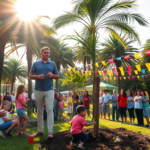Gladys Porter Zoo Welcomes New Ocelot Amid Repopulation Efforts
The Gladys Porter Zoo in Brownsville, Texas, has jubilantly announced the arrival of a 7-year-old ocelot named Ignacio, affectionately known as Iggy. This significant addition marks a pivotal step in the zoo’s ongoing efforts to boost the dwindling population of ocelots in South Texas and enhance the biodiversity of this RGV locale.
A New Hope for Ocelot Breeding
Ignacio’s arrival is part of a strategic initiative by the Gladys Porter Zoo to encourage natural breeding among its ocelot population, which currently includes Leeloo, the zoo’s existing ocelot resident. In recent years, the zoo has made multiple attempts to breed ocelots using artificial insemination without success. This new strategy, involving Ignacio as a potential mate for Leeloo, has been met with optimism.
Patrick Burchfield, Gladys Porter Zoo Director, expressed his enthusiasm. “Iggy is a lot more comfortable out on public exhibition than Leeloo was,” said Burchfield. “With Ignacio’s presence and their time together, we have renewed hope for successful natural breeding efforts.”
Challenges in Breeding Ocelots
The challenges of breeding ocelots are not unique to the Gladys Porter Zoo; they are common across nine zoos in the United States that have yet to see success in breeding these exquisite felines. Ocelots, particularly those of South American descent like Leeloo and Iggy, pose unique breeding challenges. Thus, the zoo is exploring various avenues, including acquiring genetic material from Mexican ocelots and creating a new exhibit to enhance breeding conditions.
“If we get genetic material from Mexico, we can obviously go back to artificial insemination, but we need to have the cat reproductively functional,” Burchfield added, emphasizing the importance of maintaining genetic diversity.
Impact on the Rio Grande Valley
For the Rio Grande Valley, the presence of a successful breeding pair of ocelots could mean more than just the addition of playful kittens to the zoo. It signifies the strengthening of local conservation efforts and bolsters biodiversity in an area where urban development often poses a threat to indigenous wildlife.
For Valley residents, this development brings a sense of pride and a call to better appreciate the beautiful yet fragile ecosystems surrounding them. The zoo’s initiative aligns with the broader trend in South Texas towards conservation and environmental education, speaking directly to the RGV community’s vested interest in preserving their locale’s rich natural heritage.
Connecting to Broader Issues
The zoo’s efforts tie into a larger narrative of local interest and concern for environmental sustainability and protection. It coincides with community initiatives and events that often promote wildlife preservation and engage Valley residents in educational activities. Furthermore, initiatives like the “Pump Patrol,” where locals track gas prices, and “Pet of the Week,” fostering pet adoptions, demonstrate the region’s commitment to communal welfare and conservation.
Additionally, weather patterns in the area, which include scattered showers with temperatures ranging from the 80s to 90s, may affect not only residents but also zoo planning and operations. These conditions, typical for South Texas in the fall, require strategic management to ensure the well-being of both the animals and visitors.
Future Implications for the Community
Looking ahead, the Gladys Porter Zoo’s work with ocelots has the potential to inspire regional conservation efforts across the Valley and beyond. By successfully fostering a breeding program, the zoo not only contributes to species preservation but also strengthens its role as a pillar of education and an asset to South Texas tourism.
Additionally, this could lead to increased funding and resources for similar initiatives in the Valley, illustrating the power of local action in tackling global environmental issues. From developing educational programs for schoolchildren to engaging tourists and wildlife enthusiasts, the ramifications for the local economy and education sector are broad and promising.
Community Engagement and Support
As the zoo embarks on this journey, community support remains crucial. Valley residents are encouraged to visit Gladys Porter Zoo to witness these initiatives firsthand and contribute to the conversation on conservation. Moreover, locals can share their insights and get involved through channels like the KRGV 5.1 news stream and community forums.
Overall, the arrival of Ignacio the ocelot serves not only as an exciting addition to the zoo’s family but as a symbol of the potential for positive environmental impact led by local communities. The eyes of the RGV are on this promising initiative, awaiting the new beginnings that Iggy and Leeloo may bring to their home and their species.







